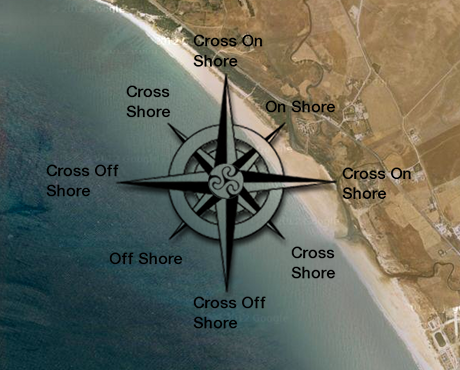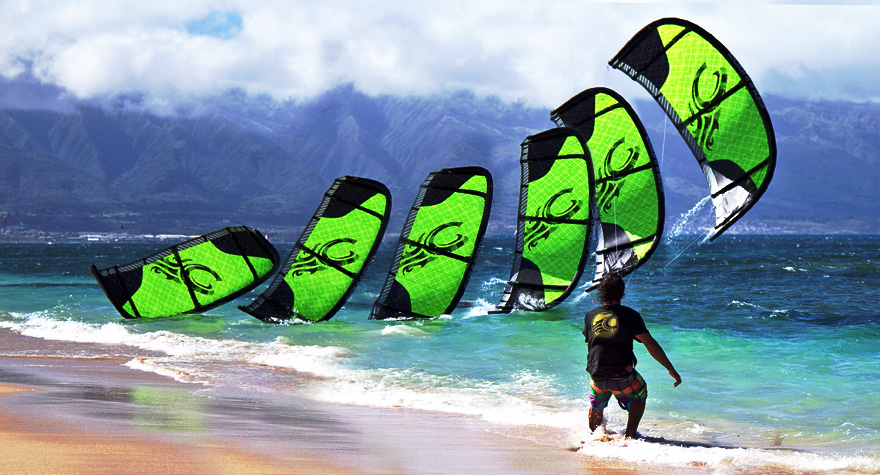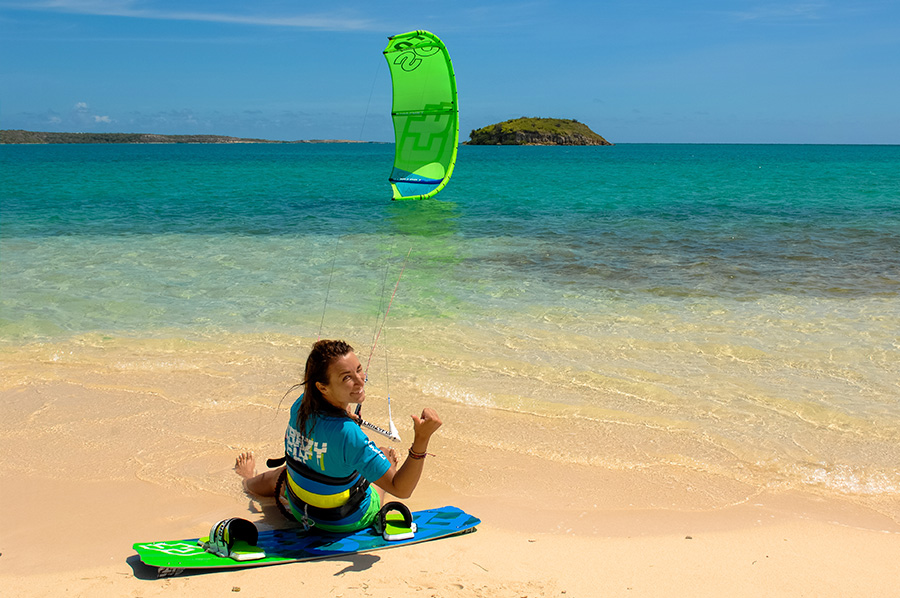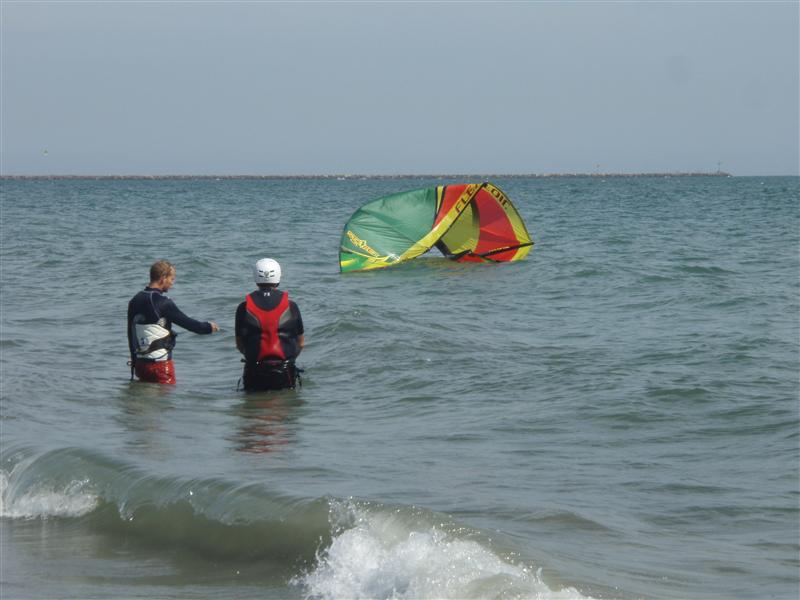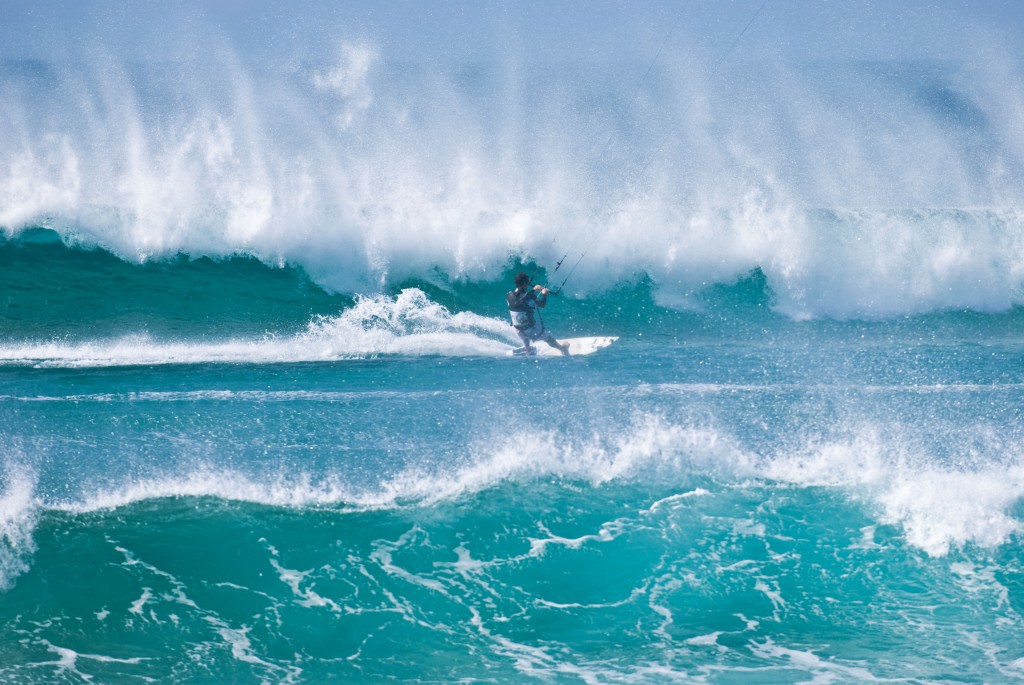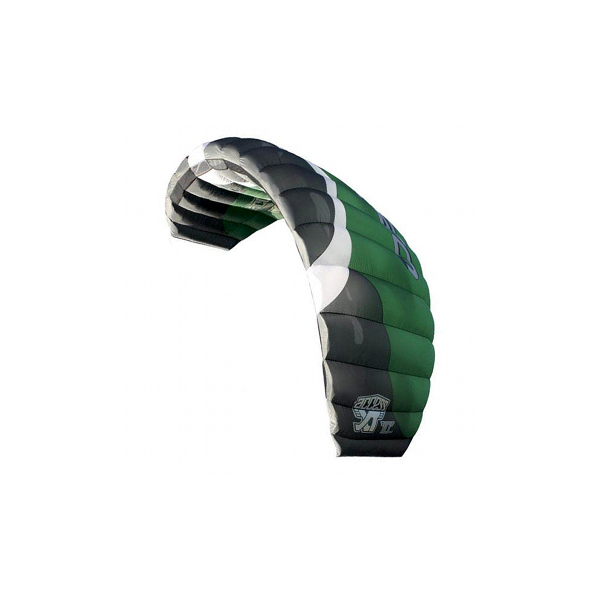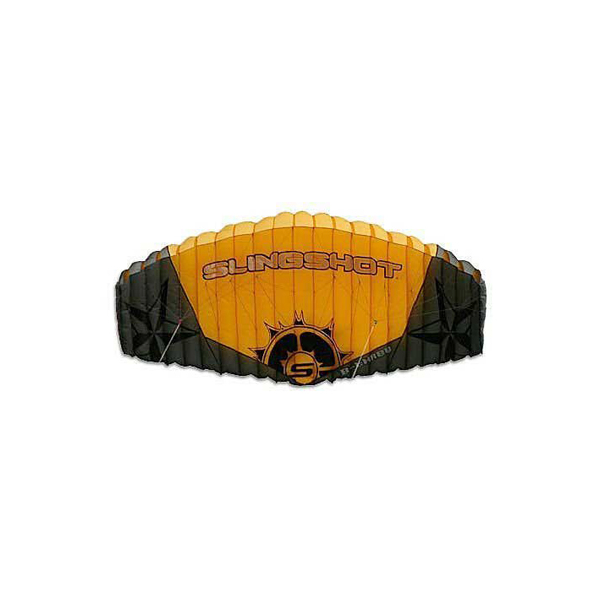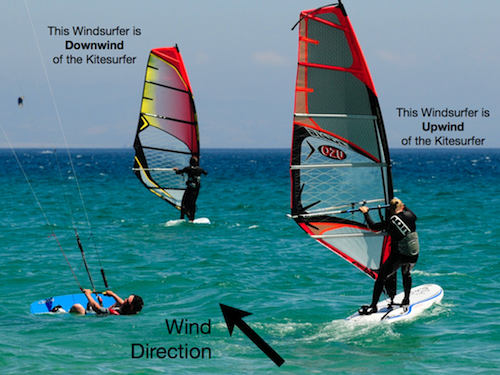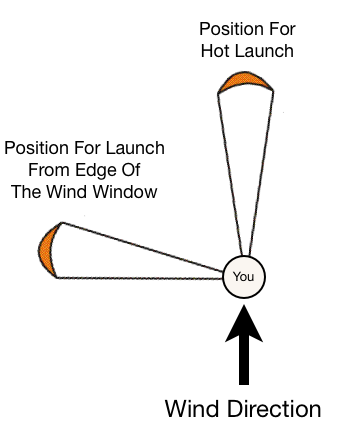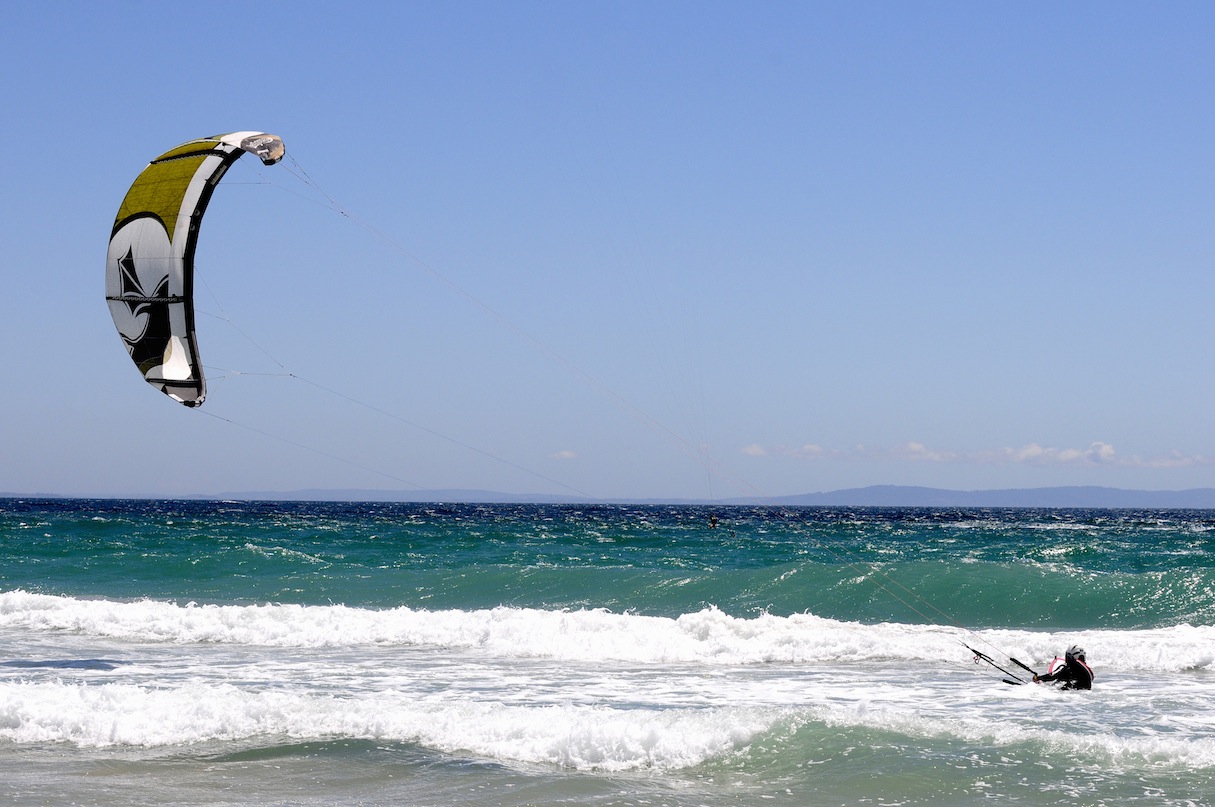
Getting Your Pinkies Wet
So we move onto our first lesson in the water. Before you take another step make sure you’ve read and fully understood the previous lessons. Humans are not designed for the water so make sure you understand what your about to get yourself into before attempting it.
The aim of body dragging is to use the kite to pull us torpedo like (or at least flapping, half drowning fish like) through the water. Once you actually “get it” it’s really easy and very enjoyable but it does take a little faith to master it.
Before You Go
Before you actually launch your kite and head to the water identify your downwind marker. This is a point visible from sea level that will serve to remind you to get out the water at this point. This should preferably be about 200m downwind and well upwind of any obstacles/hazards but will obviously depend on the beach you’re working from. My preference is for many short runs rather than fewer longer ones as they mix things up and give you a chance for a bit of a break.
Now you need to identify a point of no return. That is another marker around 100m downwind of the downwind marker that marks a point by which if you have not managed to make it out of the water by here you should simply pop your safety and self rescue in. Again the exact positioning of this point will depend on your beach but should be at least 200m upwind of any hazards.
Even if there are no hazards it is a good idea to have a point of no return marker just to ensure you don’t end up 3 miles downwind, it does happen, body dragging can be exhilarating when you get it!
Body Dragging
Having fully checked the wind direction, wave height, forecast and done a risk assessment (you have read those lessons haven’t you?) launch your kite and make your way to the water. Walk yourself out until you’re about waist depth. Now keel down (gently) in the water, this should bring you to about chest/neck deep. Doing this too violently in light winds will have the effect of pulling the kite down towards you, which can de stabailise it in the sky and leave you without control for a few critical seconds as the kite resets.
By kneeling down you’ve done 2 things. Firstly you’ve made your ‘take off’ easier by meaning that when you move forward into the body drag position you have less distance to move and so will de stabilise the kite less. Secondly you have reduced the distance you need to travel out away from the beach.
Proximity to the beach is our friend at the moment and all these next exercises are made a lot easier if you can simply stand up if something goes wrong and start again.
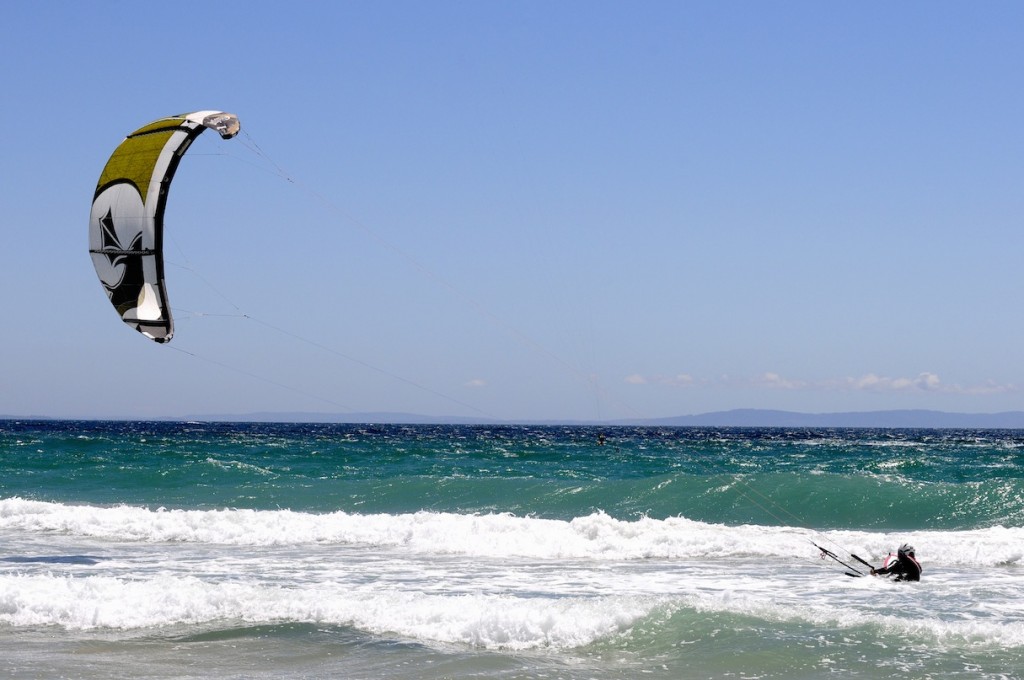
So you’re kneeling down in the water (hopefully not too far away from the beach). Now fly the kite to 12 o clock and hold it still. Next you need to gently lean forward into the superman position letting all contact with the ground go and floating in the superman position underneath the kite.
This part takes a little faith. Mainly because, especially on light wind days, it can be difficult to believe that the kite will hold you up out of the water…believe me it will.
Common Errors
There are several common mistakes that people make at this point:
Swinging Your Legs Around In Front Of You Into The Sitting Position
This one is fairly common especially on a first run, people often simply do not feel natural going into the superman position, usually caused by the (healthy) fear of your head disappearing under the water as you lean forward.
Have faith. Even underpowered on light wind days, the kite will hold you and your head out of the water. The reason we go to the superman position is because from here your legs act as a keel, keeping you straight in the water and providing you a level of stability.
As soon as you bring your legs under you into a sitting position this keel disappears and you tend to spin under the kite, often ending up upside down underneath the kite with no idea of which way is left or right…this inevitably leads you to pulling the bar the wrong way…hard.
If you do find yourself in this position just let go of the bar and start again. If the kite crashes its good relaunching practice. Either way releasing the bar gives you the time to sort yourself out again and avoid embarrassing and potentially painful encounters with the beach
Jumping Forward into the Water
Once you start to lean forward you are actually pulling the kite down with you as you fall.. On light wind days, this can have quite an effect on the kite especially if you really jump into the body drag. It is to minimise this movement that we kneel down before starting to body drag. By lessening the distance we need to ‘fall’ forward we lessen the disruptive movement on the the kite as the lines go tense and then slacken again as you bob back up to the surface.
Not Having The Kite Still At Take Off & Under Steering The Kite
Now you are in the water the physics of flying the kite change slightly. On the beach when you fly the kite, by simply leaning back you are able to provide resistance against the pull of the kite and so prevent yourself from chasing the kite downwind every time the kite gains the slightest power.
In the water this no longer applies. Every bit of power you put into the kite results in you being dragged in that direction through the water.
Once inertia is overcome you will move towards the kite. Because you are a heavier object than the kite once you start to move your momentum is greater and so you will carry on moving towards the kite until friction slows you down again. This means that every time you move the kite you actually move a little bit towards it. This results in a bit of slack going into the lines which makes the kite more sluggish to respond to your steering. Simply put you need to steer harder whilst body dragging in the water to get the same result you would expect on the land.
This is often noticeable if, when you start to body drag, the kite is already moving. As you are now moving towards the kite from the word go, there is already slack in the lines and trying to steer the other way takes a lot more steering than you are used to, having grown accustomed to flying the kite on the beach. I would recommend you to take off and keep the kite still at 12 o clock for a count of 3. Then once your happy and the kite has stabilised from the take off with tension in the lines, start to move the kite gently back and forth.
Into The Deep Blue
Once you happily dragging along behind the kite simply start moving the kite gently left and right. Noticing how you can steer yourself by doing so. Your goal here is to simply keep the kite in the sky. A good tip here is not to bring the kite too close to the edges of the window (close to the sea) as (especially on light wind days) you will find it difficult to bring the kite back up again.
Beware at this point, you will be moving fast even though it’ll probably feel as though you aren’t moving at all. Make sure before you start to body drag that you remember to look for your down wind marker…remember when choosing it, it has to something that will be visible from sea level. make sure you stick to it, you’ll most likely get there a lot faster than you think.
To get yourself back to the beach simply point the kite in that direction and hold it there until you are back on dry land. If conditions are right hopefully you’ve managed this entire exercise without ever moving out of standing depth. I realise this is an ideal, but it makes things much safer and gives you a bit more confidence if you can stay close to the shore.
Once back on dry land keep the kite flying at 45 degrees, de-powering the kite if you need to and walk back up to your start point using both hands to control the kite. Giving yourself a big pat on the back.
Changing Direction Whilst Body Dragging
This time we are going to concentrate more on using the kite to steer you. So head out exactly as before. Once you’re actually moving, use to kite to steer you in zig zags, left and right to your exit point.
At this point we want long steady pulls in either direction (while not getting too far away from the beach). So bring the kite down to one side and try to hold it in position at 45 degrees so you are heading away from the beach. Hold the kite still and after a decent amount of time (I would suggest a minimum of 10 seconds) slowly bring the kite through the 12 o’clock position and bring it down to 45 degrees on the other side. You should now be dragging back towards the beach. Again try to hold the kite still until you get far enough back in and then repeat the process heading out again.
You should now be confident to steer yourself both in and out from the beach, if not repeat the exercise until you are. Being able to control your direction is absolutely essential to keep yourself and others safe. DO NOT move on from this lesson until you can body drag in your chosen direction comfortably for at least 20 meters…preferably a lot more.
